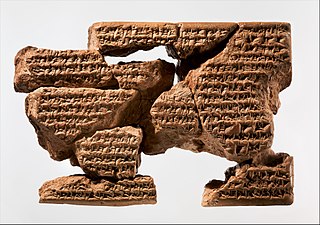 W
WThe Sargonid dynasty was the final ruling dynasty of the Neo-Assyrian Empire, ruling as kings of Assyria for just over a century from the ascent of Sargon II in 722 BC to the fall of Assyria in 609 BC. Although Assyria would ultimately fall during their rule, the Sargonid dynasty ruled the country during the apex of its power and Sargon II's three immediate successors Sennacherib, Esarhaddon and Ashurbanipal are generally regarded as three of the greatest Assyrian monarchs. Though the dynasty encompasses seven Assyrian kings, two vassal kings in Babylonia and numerous princes and princesses, the term "Sargonids" is sometimes used solely for Sennacherib, Esarhaddon and Ashurbanipal.
 W
WArda-Mulissu or Arda-Mulissi, also known as Urad-Mullissu and Arad-Ninlil and known in Hebrew writings as Adrammelech, was an ancient Assyrian prince of the Sargonid dynasty, the son of the Assyrian king Sennacherib and the older brother of Sennacherib's successor Esarhaddon. Arda-Mulissu had served as Sennacherib's crown prince and heir for several years, since the death of Sennacherib's first crown prince Ashur-nadin-shumi in 694 BC, but was for unknown reasons replaced as heir by Esarhaddon in 684 BC.
 W
WAshurbanipal, also spelled Assurbanipal, Asshurbanipal and Asurbanipal was the king of the Neo-Assyrian Empire from the death of his father Esarhaddon in 668 BC to his own death in 631 BC. The fourth king of the Sargonid dynasty, Ashurbanipal is generally remembered as the last great king of Assyria.
 W
WEsarhaddon, also spelled Essarhaddon, Assarhaddon and Ashurhaddon, was the king of the Neo-Assyrian Empire from the death of his father Sennacherib in 681 BC to his own death in 669. The third king of the Sargonid dynasty, Esarhaddon is most famous for his conquest of Egypt in 671, which made his empire the largest the world had ever seen, and for his reconstruction of Babylon, which had been destroyed by his father.
 W
WNaqi’a held an advisory position to the throne under the title of queen mother during the reigns of Esarhaddon and Ashurbanipal, her son and grandson.
 W
WSennacherib was the king of the Neo-Assyrian Empire from the death of his father Sargon II in 705 BC to his own death in 681 BC. The second king of the Sargonid dynasty, Sennacherib is among the most famous of all Assyrian kings for the role he played in the Old Testament of the Bible, which describes his campaign in the Levant. Other events of his reign which secured his legacy throughout the millennia following his death include his destruction of the city of Babylon in 689 BC and his construction of the last great Assyrian capital, Nineveh.
 W
WSerua-eterat or Serua-etirat, called Saritrah in later Aramaic texts, was an ancient Assyrian princess of the Sargonid dynasty, the eldest daughter of King Esarhaddon and the older sister of his son and successor Ashurbanipal. She is the only one of Esarhaddon's daughters to be known by name and inscriptions listing the royal children suggest that she outranked several of her brothers, such as her younger brother Ashur-mukin-paleya, but ranked below the crown princes Ashurbanipal and Shamash-shum-ukin. Her importance could be explained by her possibly being the oldest of all Esarhaddon's children.
 W
WShamash-shum-ukin or Shamashshumukin, also known as Saulmugina and Sarmuge, was the son of the Neo-Assyrian king Esarhaddon and his appointed successor as King of Babylon, ruling Babylonia from 668 BC to his death in 648 BC.
 W
WSinsharishkun or Sin-shar-ishkun was the penultimate king of Assyria, reigning from the death of his brother and predecessor Ashur-etil-ilani in 627 BC to his own death at the Fall of Nineveh in 612 BC.